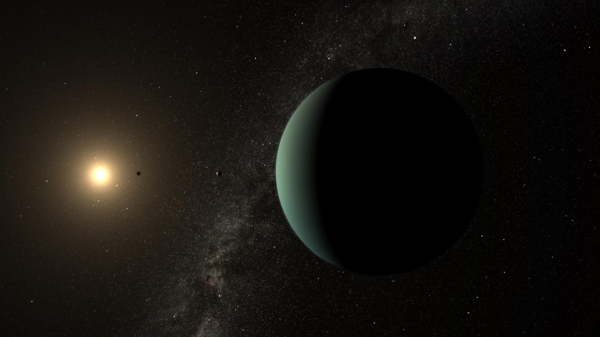Suche
Beiträge, die mit Exoplanet getaggt sind
Weltraumforschung: Astronomen in der Schweiz entdecken neuen Exoplaneten
Ein internationales Forscherteam an der Universität Genf hat einen neuen Exoplaneten entdeckt - also einen Planeten außerhalb unseres Sonnensystems. Der Planet ist rund 19 Lichtjahre von der Erde entfernt. Von P. Verne.
➡️ https://www.tagesschau.de/wissen/forschung/entdeckung-exoplanet-100.html?at_medium=mastodon&at_campaign=tagesschau.de
#Astronomie #Exoplanet #Schweiz
Ein internationales Forscherteam an der Universität Genf hat einen neuen Exoplaneten entdeckt - also einen Planeten außerhalb unseres Sonnensystems. Der Planet ist rund 19 Lichtjahre von der Erde entfernt. Von P. Verne.
➡️ https://www.tagesschau.de/wissen/forschung/entdeckung-exoplanet-100.html?at_medium=mastodon&at_campaign=tagesschau.de
#Astronomie #Exoplanet #Schweiz
#DLR:
"
Mission PLATO startet Ende 2026 mit Ariane-6-Trägerrakete
"
".. PLATO wird ab Ende 2026 mit 26 Kameras nach erdähnlichen Planeten an über 200.000 Sternen in der Milchstraße suchen
DLR leitet das Nutzlastkonsortium von PLATO und liefert Auslese-Elektronik und Elektronik zur Datenverarbeitung .."
https://www.dlr.de/de/aktuelles/nachrichten/2025/mission-plato-startet-ende-2026-mit-ariane-6-traegerrakete
30.1.2025
#Ariane6 #Astronomie #ESA #Exoplanet #Milchstraße #OHB #PLATO #Raumfahrt #SpaceFlight #Transitmethode #Weltraumteleskop
"
Mission PLATO startet Ende 2026 mit Ariane-6-Trägerrakete
"
".. PLATO wird ab Ende 2026 mit 26 Kameras nach erdähnlichen Planeten an über 200.000 Sternen in der Milchstraße suchen
DLR leitet das Nutzlastkonsortium von PLATO und liefert Auslese-Elektronik und Elektronik zur Datenverarbeitung .."
https://www.dlr.de/de/aktuelles/nachrichten/2025/mission-plato-startet-ende-2026-mit-ariane-6-traegerrakete
30.1.2025
#Ariane6 #Astronomie #ESA #Exoplanet #Milchstraße #OHB #PLATO #Raumfahrt #SpaceFlight #Transitmethode #Weltraumteleskop

Mission PLATO startet Ende 2026 mit Ariane-6-Trägerrakete
Am 29. Januar 2025 unterzeichneten ESA und Arianespace den Startvertrag für die Raumfahrtmission PLATO.www.dlr.de
Achtung, Turbulenzen! Flug nach WASP-127b wegen 33.000 km/h Winden verschoben. Piloten empfehlen: Anschnallen und Tüten bereithalten. #Exoplanet https://winfuture.de/news,148359.html?utm_source=Mastodon&utm_medium=ManualStatus&utm_campaign=SocialMedia

Winde mit 33.000 km/h: Supersonic-Planet mit Rekord-Wetter entdeckt
Astronomen haben auf einem Exoplaneten Winde mit Rekordgeschwindigkeiten von 33.000 km/h entdeckt. Die Supersonic-Jetstreams am Äquator des Planeten sind die schnellsten Winde im bekannten Kosmos und zeigen die extremen Wettermuster ferner Welten.John Woll (WinFuture.de)
[Atmosphere, atmosphere ... ] 33,000 km/h, i.e. 9 km/sec! This is the speed of the #winds in the jet stream that encircles the equator of #exoplanet WASP-127b, a gas giant located some 520 light-years from Earth. Molecules of water vapor and carbon monoxide were also detected within this planetary #atmosphere.
The extreme meteorological conditions prevailing on the surface of WASP-127b were deduced from measurements made using the CRIRES+ instrument installed on the Very Large Telescope (VLT) of the @esoastronomy (ESO).
Details+ : https://www.irap.omp.eu/en/2025/01/extreme-supersonic-winds-measured-on-planet-outside-our-solar-system/
#astronomy #astrophysics #exoplanet
The extreme meteorological conditions prevailing on the surface of WASP-127b were deduced from measurements made using the CRIRES+ instrument installed on the Very Large Telescope (VLT) of the @esoastronomy (ESO).
Details+ : https://www.irap.omp.eu/en/2025/01/extreme-supersonic-winds-measured-on-planet-outside-our-solar-system/
#astronomy #astrophysics #exoplanet


